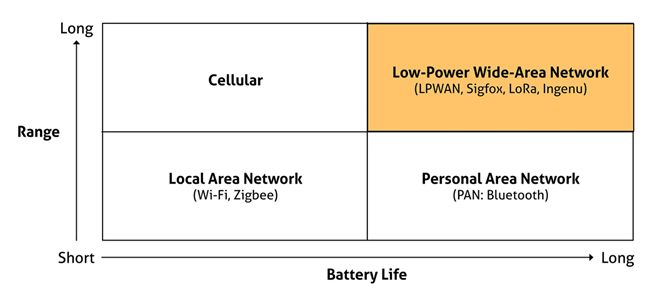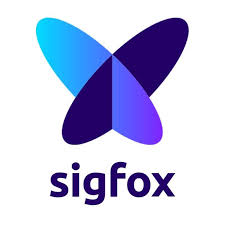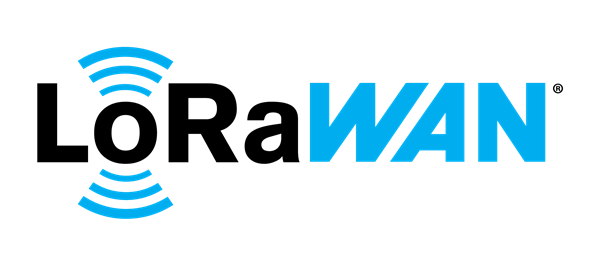In the last couple of blogs we have discussed the connectivity framework that is required to allows IoT devices to be effective. This week, we are discussing Low Power Wide Area Network (LPWAN) technology.
When it comes to connecting IoT devices, there are an overwhelming number of options. Connectivity is a huge facet of IoT. It’s important to understand the options so assets can be managed with the lowest sensible cost. The most popular and generally most sensible of the connectivity options is LPWAN. There are many LPWAN technologies that operate on the low frequencies in the radio spectrum.

For our purposes, asset management of devices requires long ranges and long battery life devices.
LPWAN
Low-Power Wide-Area Networks (LPWANs) are a wireless technology that allow for low power consumption over a wide area. Packets of data or messages sent over LPWAN must be small and simple. Because of their simplicity, these messages can be communicated over the distance without a large power source. For machines, decreasing the amount of data sent means lower energy at range. LPWANs send and receive small packets of information at infrequent intervals. Sensor/devices can send data over kilometers of range instead of meters. Devices using LPWAN can also last for years on battery instead of weeks or months.
There are many types of LPWAN technology standards all operating in different radio bands. Each type has it’s own merits and limitations. In NZ, Spark, Kordia and Vodafone have deployed LPWAN IoT focused networks that operates on low-band 5G bands.
In this blog series we will discuss the four of the most widely available LPWANs. This blog covers two of these technologies, the remaining two will be covered in next weeks blog. For each of these networks we will explore the following –
Frequency - rough bands they use, this is different for each telco and can be different in other countries. Sometimes the exact band isn’t publicly available. The purpose of examining this is so we can rank technologies by metrics.
Coverage – as discussed before this is linked to the frequency. Again there are many variables including the hardware used and a generalized number is used to be able to compare.
Bandwidth size – this helps us understand what sized information can be send on this network. By nature LPWAN networks are very small bandwidth networks. Some are only one way too. The numbers discussed here are the potential limit
Provider – Which of the New Zealand telcos support this network?

Frequency: 200kz
Coverage: <50km
Bandwidth size: 100bytes
Provider: Kordia and partner Thinxtra built the Sigfox network that is currently live in NZ.
Founded in 2009, Sigfox is a French company that has designed and developed this type of LPWAN technology by the same name. So to be clear, we have Sigfox "the company" and Sigfox "the technology".
Sigfox has been a pioneer in developing a network specifically designed for IoT applications. Being one of the first Sigfox has the most connected devices when compared to any other LPWAN. It generally achieves the biggest coverage, but can only send very small packets of information. In most cases, Sigfox devices can only communicate in one direction.
Sigfox technology is suitable for applications where devices:
- Need to be low cost
- Send small amounts of data infrequently
- Use one-way communication (device to base station direction only)
- Transmits non-critical information only
A good example would be a remote temperature sensor. Such a device could be manufactured in large quantities at low cost. Further, it would only ever transmit a small amount of data and infrequent measurements (say hourly). Also, one-way communication would be suitable as data would only ever be sent from the temperature devices to the receiving base station.
On the other hand, if your application requires high amounts of data or two-way communication Sigfox is likely not the LPWAN technology for your solution.

Frequency: 915Mhz
Coverage: <20km
Bandwidth size: 50kbps
Provider: Spark’s LoRaWAN network that is currently live. Vodafone do not have LoRaWAN network
LoRaWAN is a LPWAN that supports low-cost, mobile, and secure bi-directional communication for IoT devices. LoRaWAN is optimized for low power consumption and is designed to support large networks with millions of devices in urban environments. LoRaWAN is preferred for static devices that don’t move around too much and can be setup faster than NB-IoT networks in broad strokes.
One of the first customers for Spark on their LoRaWAN network is Levno, who offers a rural fuel tank monitoring service. Levno's system consists of a battery-powered sensor attached to the fuel tank reporting changes in volume, with this information getting sent, via the cloud, to the customer’s device. When fuel levels get low, the fuel distributor is notified that a delivery is needed. As part of Levno's agreement with Spark, the IoT network is being extended to service customers in Manawatu, Canterbury and Waikato. The system provides three main benefits: stopping fuel theft, managing fuel allocation and stock reconciliation.
Next week, we’ll share information on 2 more popular LPWAN technologies – NB-IoT and CAT M1, along with Cellular networks like the ones our smart phones use.
Quadrent provides hassle free technology leasing to help companies achieve their most ambitious goals, whether that be supercharging their current workflows with an IoT infrastructure or empowering staff with . We’d love to have a chat about technology goals. Reach out to Arnold here.
